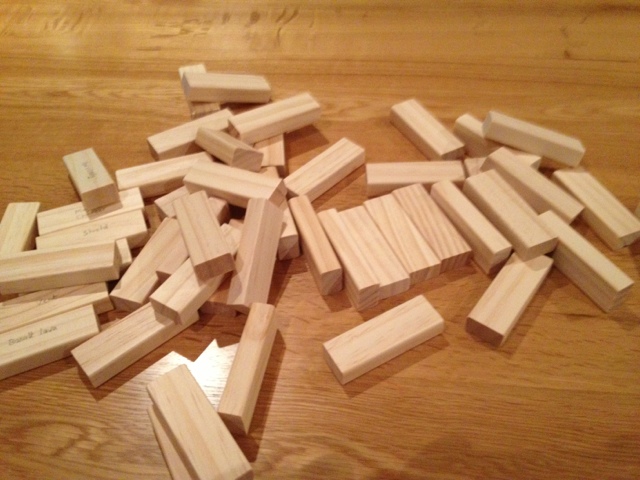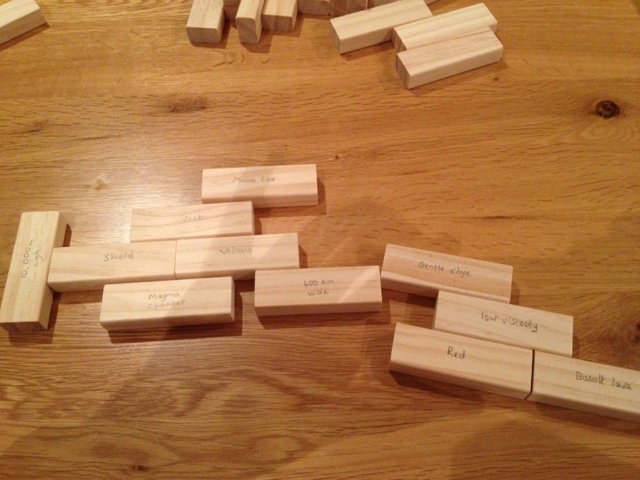At the weekend one of my best friends @redhea79 took me out for a walk. As always with us it didn't take long for the conversation to focus on teaching (I know, I know).
Andy have me a strategy that he has used and I LOVE IT!
Firstly you need a set of Jenga like bricks. Tesco do a set called 'Stack Em' and they cost £5.
These are the stimulus resource.
1. At the end of a topic or earlier get students to say not on each brick a keyword from the topic. This is a quick AfL task as you can see what they remember. I get mine to do it as a quick plenary or a quick starter.
2. These keywords could be checked against those have noted on the board. Next I get mine to colour the bricks. This can already be done by you but i get students to do it as a bit of success criteria development against level ability.
The more difficult terms naturally relate to higher level thinking down to the name of a landform as low level. I get students to do this on the outside of the brick. See pic students could then stack them related to significance, cost, creating a ranking sequence to the tower. They could evaluate each others blocks and students try to work out how they are ranked.
The block could be classified into human / physical or environmental. So before you even play the game you have thinking driving the learning:)
Now we have our keywords and they are connected to specific levels. Now it is time for a game! See pic. Students in tables of 4 in my room play to remove the bricks. They can do that related to their target so if they are a level 4 they go for pinks or if they are a 5 the orange. Or go a great up go for a challenge. When the student draws out a word they have to say what it is. the rest on the table could do a Kagan task with it to keep then active rather than passive. 1s draw it, 2s describe it, 3s associate or dissociate from it with another brick for 6 degrees of separation from it or say as many words that are connected to it and count. I use this as a quick timer for the others. All the connected words they are saying the others are describing, drawing, the 4 sides to the brick could link to categories such as economic, environmental, social; or the 2 opposite sides opposites or positives/negatives. And so it continues.... Each brick that comes out, students can try and think off an overall connection or a theme for later that they will use with that keyword as the focus (linked to brains on the table). Some of you may not agree with the use of levels against the key terms I feel I am getting some qualitative formative assessment from it later on from it by verbally checking students.
The game will play out till the block collapses. Then we move onto the next task of 'Brains on the Table' the idea is that students sort the bricks however they want to (or by the criteria you give them on the board. So that you have control if you feel you need it to then make a direct comparison between groups. Students could then cross to another groups brain on the table to get ideas, compare / contrast ask for help a hint etc. I got students to do solo connecting of a landform. Create a list of bricks for a specific landform say like in my example :
A Volcano
Do students know the 2 types they need to know for the exam? I can check so a hinge point question to start.
Do they know one thing about this type of volcano to make them a uni structural learner? They might know it has gentle slopes. See pic
Multistructural students bring in more bricks to surround it but they are not connected they are just associated with a shield volcano. See pic
Relational students are creating links between the key words so for example they are connecting gentle slopes with low viscosity basalt lava.
Students could then with all these key terms draw on paper or I prefer the table with a whiteboard pen a diagram to incorporate the key terms and to keep connected parts together.
Students could take one of the keyword and change the focus of it all or take of the key words and apply it to something else - extended abstract thinking:)
Each table of students could have different terms in their pack and so then you could create cross table bridges to connect terms together for the big picture:)
You could write differentiated terms around the brick so runny lava on simple term side becomes low viscosity basaltic lava on the Geography Key side:)
There are other ways of using the bricks but I will happily hand it over to you to post a comment on how else say in another subject or geography you could use this resource:)
This is one way I use it:)










Excellent idea and really well put across.
ReplyDeleteIve just done population, so I would have given a blank DTM and had labels for the basic structure and then a selection of living graph comments that students could come up with- they could label them for another group to use?
One question.....did the pencil/colours easily come off the bricks?
thanks again
Paul :-)